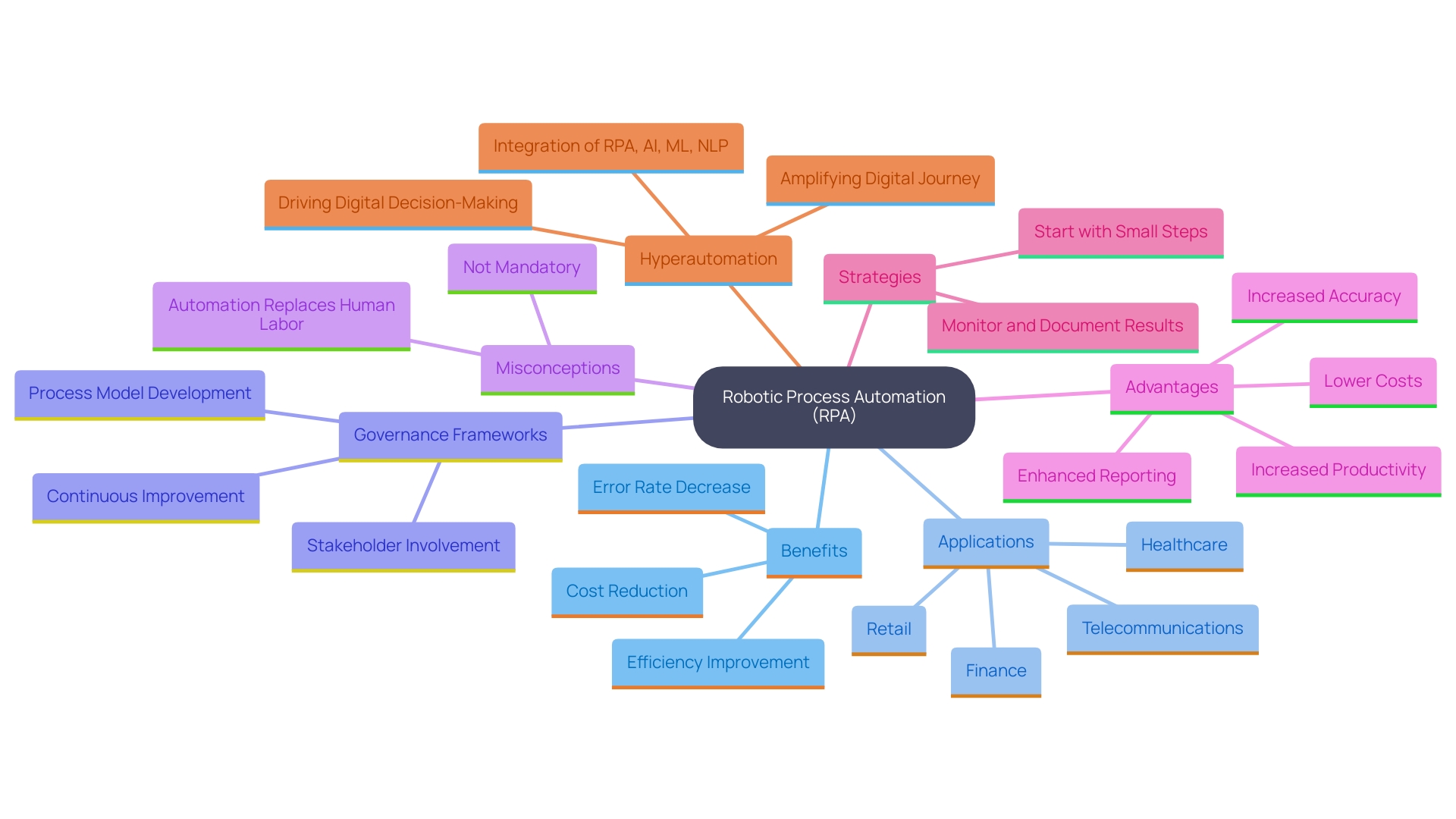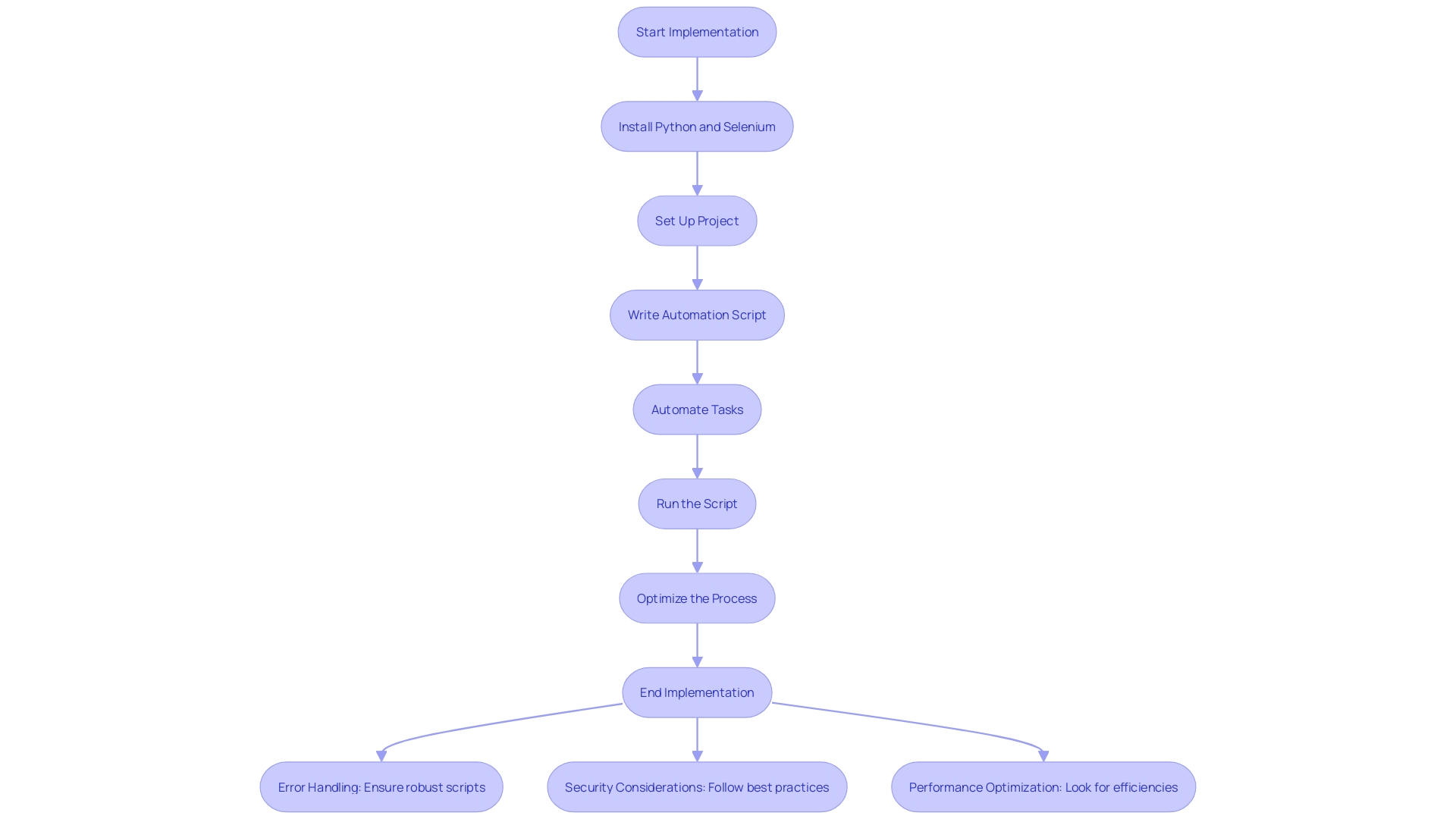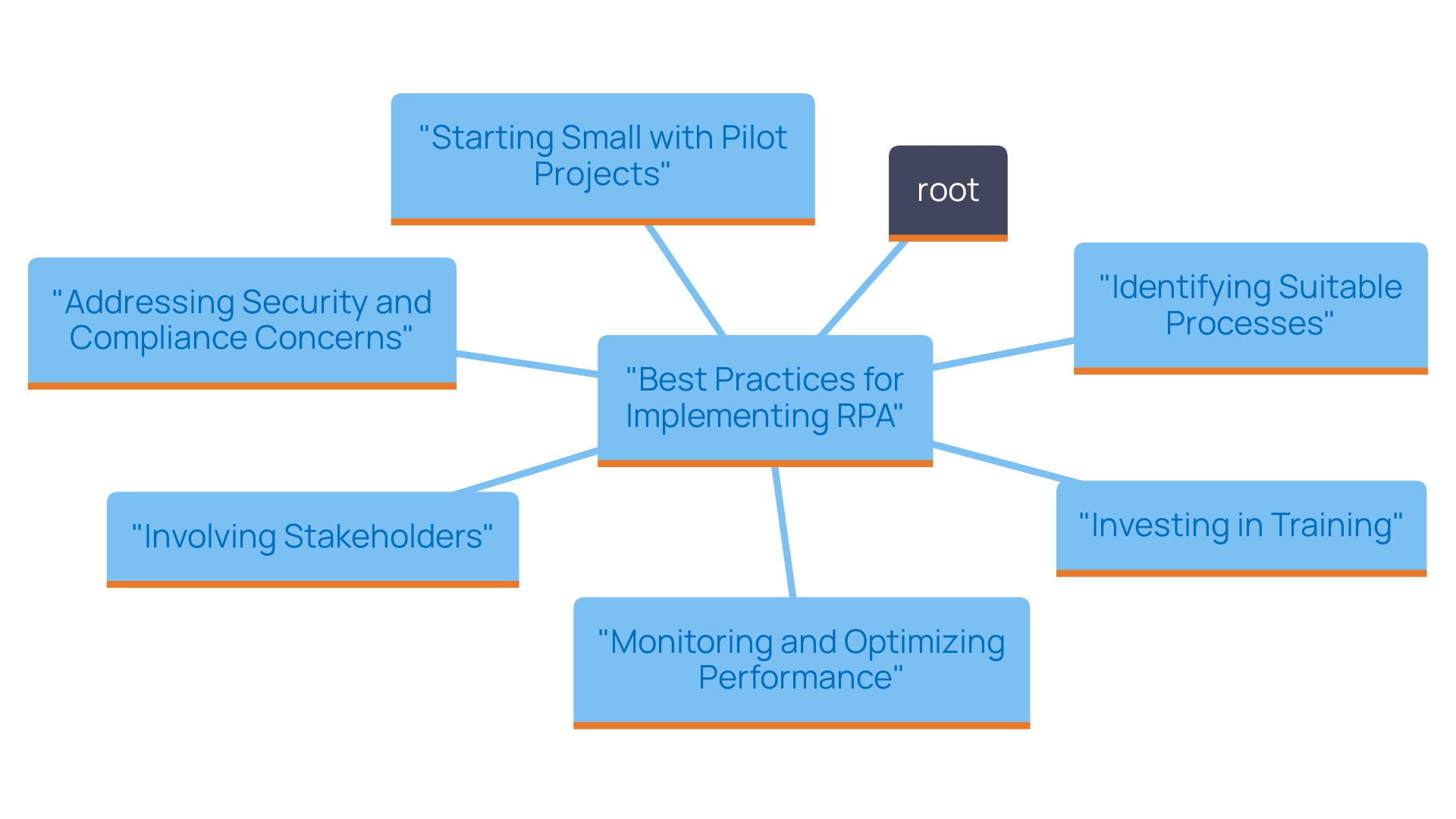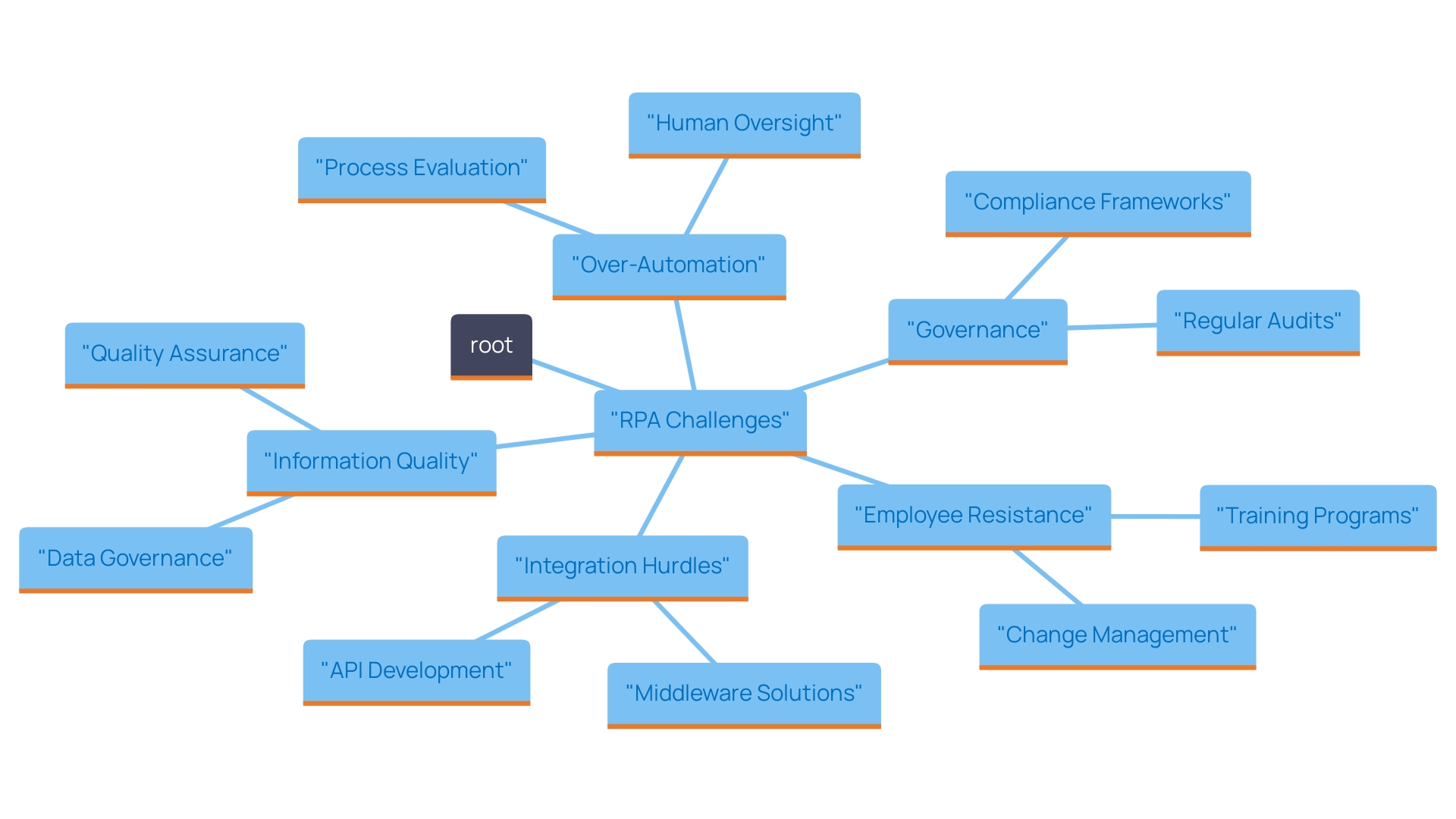Introduction
In the evolving landscape of business operations, Robotic Process Automation (RPA) emerges as a transformative force, reshaping how organizations tackle repetitive tasks and streamline workflows. By deploying intelligent software bots, companies can not only reduce operational costs but also enhance accuracy and efficiency across various sectors, from finance to healthcare. As the trend toward automation accelerates, understanding the intricacies of implementing RPA becomes crucial for leaders looking to harness its full potential.
This article delves into the essential steps for integrating RPA using Python and Selenium, outlines best practices for successful implementation, and addresses common challenges organizations may face along the way. With a strategic approach, RPA can serve as a catalyst for innovation and productivity, positioning businesses for sustained success in an increasingly automated world.
Introduction to Robotic Process Automation (RPA)
Robotic Process Automation (RPA) is a revolutionary technology that allows organizations to automate tedious and repetitive tasks through the deployment of software robots. These clever bots are designed to replicate human actions, effectively managing tasks such as entry, transaction processing, and record management. By embracing RPA, businesses can achieve substantial reductions in operational costs, drastically decrease error rates, and allocate human resources to more strategic and value-added initiatives.
Particularly in sectors like finance and healthcare, where the volume of routine tasks is significant, RPA serves as a game changer. For instance, a mid-sized company enhanced efficiency by automating information entry, software testing, and legacy system integration using GUI automation. This implementation reduced data entry errors by 70%, accelerated testing processes by 50%, and improved workflow efficiency by 80%, achieving ROI within six months. Additionally, RPA has proven beneficial in industries such as retail, where it streamlines inventory management and order processing, and in telecommunications, where it automates customer service inquiries and billing processes.
As we approach 2024, current statistics show a growing trend in RPA adoption, with recent reports indicating that 45% of entities are planning to implement RPA solutions within the next year. This growing acceptance highlights that companies recognize the importance of leveraging this technology not only to enhance productivity but also to remain competitive in an increasingly automated world. The continuous evolution of RPA capabilities suggests that the benefits will only multiply, making it essential for leaders to understand and implement this technology within their operational frameworks.
With RPA’s potential unfolding, it is imperative to establish guiding principles that ensure its advantages are maximized while minimizing any associated downsides. Organizations should develop clear governance frameworks that define roles and responsibilities, establish metrics for success, and ensure compliance with industry regulations. By doing so, entities can harness RPA not just as a tool for efficiency, but as a strategic partner in their growth journey.

Step-by-Step Guide to Implementing RPA with Python and Selenium
To successfully implement RPA using Python and Selenium and address key workplace challenges such as repetitive tasks, staffing shortages, and outdated systems, follow these essential steps:
-
Install Python and Selenium: Start by downloading Python from the official website. After installation, utilize pip to install the Selenium package by executing the command
pip install seleniumin your command prompt. -
Download a Web Driver: Selenium requires a web driver to communicate with your browser. If you are using Chrome, download the ChromeDriver that corresponds with your browser version from the official site.
-
Set Up Your Project: Create a new Python project in your preferred integrated development environment (IDE), such as PyCharm or VS Code. Ensure to add the necessary libraries, beginning with importing the Selenium package in your Python script.
-
Write Your Script: Begin by importing the needed modules:
python
from selenium import webdriver
from selenium.webdriver.common.by import By
Next, initialize the web driver:
python
driver = webdriver.Chrome(executable_path='path/to/chromedriver')
Be sure to replace'path/to/chromedriver'with the actual path to the ChromeDriver on your system. -
Automate a Simple Task: To illustrate automation, consider a login process:
python
driver.get('http://example.com/login')
driver.find_element(By.ID, 'username').send_keys('your_username')
driver.find_element(By.ID, 'password').send_keys('your_password')
driver.find_element(By.ID, 'login-button').click()
This script directs the browser to your login page, inputs your credentials, and activates the login button. -
Run Your Script: Save your script and execute it. Watch as the browser performs the programmed actions! If all goes well, you’ve successfully completed your first RPA task using Python and Selenium, enhancing operational efficiency and freeing your team for more strategic work.
-
Expand and Optimize: As you gain familiarity, delve into more advanced features of Selenium, like handling alerts or navigating across multiple pages. It’s also beneficial to incorporate error handling, which enhances the robustness of your scripts.
Statistics and Trends
According to recent data, the usage of Python and Selenium for RPA has been steadily increasing, with a projected growth rate of 25% in 2024, as organizations recognize the value of these tools for enhancing operational efficiency. This foundational process not only establishes your RPA capabilities but also prepares the way for more complex tasks. With the rising trend of hyper-automation, integrating RPA with AI, machine learning, and natural language processing can significantly enhance your projects. Industry experts like Shailesh Gohel emphasize the promising future of RPA, particularly as major companies invest in these technologies and as open-source RPA solutions gain traction. By implementing these steps, you can not only tackle immediate operational challenges but also position your entity for sustained productivity and innovation.

Best Practices for RPA Implementation
To achieve a successful implementation of Robotic Process Automation (RPA), it is essential to adhere to several best practices designed to streamline your efforts and maximize outcomes:
-
Identify Suitable Processes for Automation: Concentrate on tasks that are repetitive and rule-based, which require minimal human judgment. Employ process mapping techniques to visualize workflows, allowing you to pinpoint specific tasks that are prime candidates for RPA integration. This strategic method improves efficiency and creates a strong base for automated processes, allowing your entity to utilize RPA effectively in a swiftly changing AI environment.
-
Start Small: Initiate your RPA journey with a pilot project to evaluate feasibility and effectiveness within your organization. This approach allows for valuable insights and adjustments to be made before scaling up operations. By selecting a manageable scope, you mitigate risks and create a platform for success. Studies indicate that pilot RPA projects have shown an average success rate of over 70%, underscoring the strong potential for scalability and enhanced business productivity.
-
Involve Stakeholders: Early engagement of relevant stakeholders is crucial for gathering insights and securing buy-in. This collaborative method promotes a supportive atmosphere, ensuring that concerns are addressed and that there is a shared vision for the initiative, which is essential for overcoming technology implementation challenges.
-
Monitor and Optimize: Post-implementation, continuously monitor the performance of your RPA solutions. Utilizing analytics tools enables you to measure efficiency gains and identify areas for further improvement. This ongoing evaluation is vital for maximizing the value of your automation efforts and ensuring that tailored AI solutions effectively contribute to informed decision-making.
-
Invest in Training: Providing your team with comprehensive training on RPA tools and best practices is critical. This investment enhances their capability to manage and troubleshoot automated processes, ensuring that the transition to RPA is smooth and that the potential of the technology is fully realized.
Moreover, as you explore RPA, it is imperative to address security and compliance concerns, especially given the sensitive nature of the information involved. To mitigate risks, integrate robust information security mechanisms into your RPA framework from the outset. This proactive strategy will safeguard against potential breaches, protecting both your organization’s reputation and financial standing. For instance, implementing encryption protocols and access controls can significantly enhance data security.
Drawing from successful case studies, such as those in marketing technology, RPA has proven transformative across various industries, including insurance. Companies have utilized RPA for market analysis and segmentation, leading to a 30% increase in outreach effectiveness. By adopting these best practices and leveraging industry insights, you can ensure a successful RPA implementation that not only meets compliance standards but also drives significant operational improvements.

Addressing Common Challenges in RPA Implementation
Implementing Robotic Process Automation (RPA) can present various challenges, but understanding these obstacles and strategically addressing them can pave the way for successful deployment. Here are some common issues and actionable solutions to consider:
-
Resistance to Change: A prevalent issue in RPA implementation is employee resistance, often stemming from fears of job displacement. According to recent studies, nearly 60% of employees express concerns about technology leading to job loss. To counteract this, it’s essential to communicate the advantages of RPA clearly. Emphasize how automation can enhance their roles by freeing them from mundane tasks, allowing them to focus on higher-value activities that require human insight and creativity.
-
Integration with Legacy Systems: Many organizations still rely on legacy systems that may pose integration hurdles with modern RPA solutions. Conduct a comprehensive assessment of your IT infrastructure to identify potential compatibility issues. Solutions such as middleware can facilitate smoother integration, enabling RPA tools to interact seamlessly with existing systems. For instance, a financial services company successfully integrated RPA with its legacy accounting software, resulting in a 30% reduction in processing time.
-
Information Quality Issues: The effectiveness of RPA is heavily dependent on the quality of the information it processes. Inconsistent or flawed information can lead to subpar outcomes. Before implementing RPA, invest in strong information purification and quality assurance processes to guarantee that your records are reliable, thereby maximizing the system’s potential. A retail chain improved its RPA results by 40% after establishing a dedicated data governance team to oversee data quality.
-
Over-automation: A common pitfall is the temptation to automate numerous processes simultaneously, which can lead to increased complexity and confusion. It’s advisable to adopt an incremental approach, starting with the most critical processes that promise significant efficiency gains. Slowly increase mechanization initiatives as the entity adjusts to the changes. For example, a healthcare provider began by automating appointment scheduling before moving on to billing and claims processing.
-
Lack of Governance: Establishing a strong governance framework is crucial for overseeing RPA initiatives. This framework should ensure compliance and effective risk management. Clearly defining roles, responsibilities, and success metrics will empower teams to navigate the complexities of RPA deployment confidently.
As enterprises advance their use of AI and automation technologies, the importance of a structured approach becomes evident. Mario Schlener from EY highlights the need for a foundation built on solid governance principles, stating,
“As enterprises advance the use of AI in their organizations, it is essential to have confidence in the data and models/solutions/systems that feed their analyses and decisions.”
Empowering employees through engagement and education, alongside robust governance, can significantly enhance the acceptance and efficacy of RPA solutions. By leveraging tailored AI solutions and Business Intelligence, organizations can make informed decisions that drive growth and innovation, ultimately overcoming challenges and enhancing productivity.

Conclusion
Robotic Process Automation (RPA) stands at the forefront of operational transformation, enabling organizations to automate repetitive tasks and streamline workflows effectively. By implementing RPA using Python and Selenium, companies can significantly enhance their productivity while reducing operational costs and error rates. The step-by-step guide provided illustrates how straightforward it is to start automating tasks, empowering teams to focus on strategic initiatives that drive value for the organization.
However, successful RPA implementation goes beyond just technical execution. It requires a strategic approach that includes identifying suitable processes for automation, starting with pilot projects, involving stakeholders, and continuously monitoring performance. By adhering to these best practices, organizations can maximize the benefits of RPA while addressing common challenges such as resistance to change and integration with legacy systems.
In an increasingly automated world, the potential of RPA is vast and still unfolding. Leaders who invest in understanding and deploying RPA technologies will not only improve their operational efficiency but also position their organizations for future growth and innovation. Embracing this transformative technology is not just about current efficiency gains; it is about laying the groundwork for a more agile and competitive business landscape.
Now is the time to leverage RPA as a strategic partner in the journey toward operational excellence.

